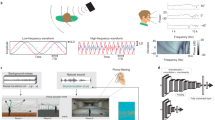Abstract
Propagation and reverberation of excitation patterns are investigated for 1-dimensional and 2-dimensional homogeneous nets of neuron-like elements. A 1-dimensional net has a proper set of excitation patterns which only can be conducted in the net. Such a net has an ability of discriminating and shaping stimulus signals. Two types of self-reproducing reverberatory excitation patterns are shown for 2-dimensional homogeneous nets. An algebraic theory of general homogeneous nets is also developed.
Similar content being viewed by others
References
Amari, S.: One-dimensional threshold element nets of homogeneous structure (in Japanese). PGA, Inst. Electron. Commun. Eng. Jap., Paper A71-23 (1971a)
Amari, S.: Characteristics of randomly connected threshold element networks and network systems. Proc. IEEE 59, 35–47 (1971b)
Amari, S.: Characteristics of random nets of analog neuron-like elements. IEEE Trans. Systems, Man and Cybernetics SMC-2, 643–657 (1972a)
Amari, S.: Learning patterns and pattern sequences by self-organizing nets of threshold elements. IEEE Trans. Comput. C-21, 1197–1206 (1972b)
Amari, S.: A method of statistical neurodynamics. Kybernetik 14, 201–215 (1974a)
Amari, S.: A mathematical theory of nerve nets. Advances in biophysics 6, Kotani, M. (Ed.), Tokyo and Baltimore: University of Tokyo Press and University Park Press 1974b
Amari, S., Kohda, T.: A one-dimensional nerve net of homogeneous structure with monotonically decreasing coupling coefficients (in Japanese). Trans. IECE, Jap. 56-D, 349–356 (1973)
Abramova, N.A.: Homogeneous logic networks and their automorphism groups. Automat. Telemekh. 120–129 (1970)
Beurle, R.L.: Properties of a mass of cells capable of regenerating pulses. Phil. Trans. roy. Soc. (Lond.) B 240, 55–94 (1956)
Crane, H.D.: Neurister — a novel device and system concept. Proc. IRE 50, 2048–2060 (1962)
Farley, B.G.: Some similarities between the behavior of a neural network model and electrophysiological experiments. Selforganizing systems. Yovits, M.G., Jacobi, G.T., Goldstein, G.D. (Eds.), Washington, D.C.: Spartan 1962
Farley, B.G., Clark, A., jr.: Activities in networks of neuron-like elements. Proc. 4th London Symp. Inf. Theory, Cherry, C. (Ed.), London: Butterworths 1961
Griffith, J.S.: A field theory of neural nets I. Bull. math. Biophys. 25, 111–120 (1963)
Griffith, J.S.: A field theory of neural nets II. Bull. math. Biophys. 27, 187–195 (1965)
Hennie, F.C.: Iterative arrays of logical circuit. Massachusetts, New York and London: MIT Press and Wiley 1961
Kohda, T.: Synthesis of one-dimensional threshold element nets of homogeneous structure (in Japanese). PGA, Inst. Electron. Commun. Eng. Jap., Paper A 71-24 (1971)
Kohda, T., Amari, S.: A one-dimensional nerve net of homogeneous structure with fixed signal propagation velocity (in Japanese). Trans. IECE, Jap. 56-D, 357–364 (1973)
Morishita, I., Yajima, A.: Analysis and simulation of networks of mutually inhibiting neurons. Kybernetik 11, 154–165 (1972)
Suzuki, R., Katsuno, I., Matano, K.: Dynamics of “neuron ring”. Kybernetik 8, 39–45 (1971)
Mylopoulos, J.P., Pavlidis, T.: On the topological properties of quantized spaces. J. Ass. Comp. Mach. 18, 239–246 (1971)
Von Neuman, J.: The theory of self-reproducing automata. Burks, A.W. (Ed.), Urbana, Ill.: University of Illinois Press 1966
Wiener, N., Rosenblueth, A.: The mathematical formulation of the problem of conduction of impulses in a network of connected excitable elements, specifically in cardiac muscle. Arch. Inst. Cardiol. (Mexico) 16, 205–265 (1946)
Wilson, H.R., Cowan, J.D.: A mathematical theory of the functional dynamics of cortical and thalamic nervous tissue. Kybernetik 13, 55–80 (1973)
Yamada, H., Amoroso, S.: Tesselation automata. Inf. and Cont. 14, 299–317 (1971)
Yamada, S., Amoroso, S.: Structural and behavioral equivalence of tesselation automata. Inf. and Cont. 18, 1–31 (1971)
Yoshizawa, S., Nagumo, J.: Propagation of excitations in a neural network model with uniform structure (in Japanese). PGMBE, Inst. Electron. Commun. Eng. Jap., Paper MBE 69-14, 1969
Author information
Authors and Affiliations
Rights and permissions
About this article
Cite this article
Amari, SI. Homogeneous nets of neuron-like elements. Biol. Cybernetics 17, 211–220 (1975). https://doi.org/10.1007/BF00339367
Received:
Issue Date:
DOI: https://doi.org/10.1007/BF00339367




